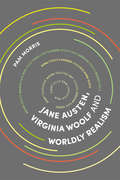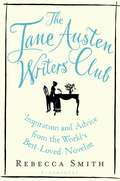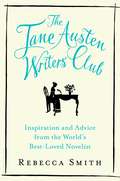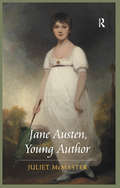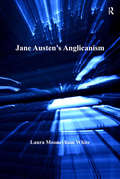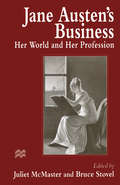- Table View
- List View
Jane Austen: Northanger Abbey/Persuasion (Readers' Guides to Essential Criticism)
by Enit Karafili SteinerNorthanger Abbey was one of Jane Austen's earliest manuscripts; Persuasion was her last. Published together in a single volume after her death, the two books differ widely. Northanger Abbey is a spirited, Gothic parody, while Persuasion has increasingly been seen as a new direction for the Austen canon. The two texts have been widely analysed and debated since publication, and continue to be so today. In this Readers' Guide, Enit Karafili Steiner:• delineates a clear trajectory through the books' many interpretations over two centuries, mapping these out thematically and chronologically• contextualises and brings into dialogue influential approaches such as psychoanalytical criticism, structuralism, deconstruction, Marxism, New Historicism, and feminism• discusses film adaptations of the novels and their relation to literary criticism
Jane Austen: Northanger Abbey/Persuasion (Readers' Guides to Essential Criticism)
by Enit Karafili SteinerNorthanger Abbey was one of Jane Austen's earliest manuscripts; Persuasion was her last. Published together in a single volume after her death, the two books differ widely. Northanger Abbey is a spirited, Gothic parody, while Persuasion has increasingly been seen as a new direction for the Austen canon. The two texts have been widely analysed and debated since publication, and continue to be so today.In this Readers' Guide, Enit Karafili Steiner:- Delineates a clear trajectory through the books' many interpretations over two centuries, mapping these out thematically and chronologically.- Contextualises and brings into dialogue influential approaches such as psychoanalytical criticism, structuralism, deconstruction, Marxism, New Historicism, and feminism.- Discusses film adaptations of the novels and their relation to literary criticism.
Jane Austen on Love and Romance
by Constance Moore'There are certainly not so many men of large fortune in the world, as there are pretty women to deserve them' If you want to make like Elizabeth Bennet and live happily ever after with a man who owns half of Derbyshire, then arm yourself with this Austen-tatious guide to flirting and courtship.
Jane Austen, or The Secret of Style
by D. A. MillerWhat is the world-historical importance of Jane Austen? An old maid writes with the detachment of a god. Here, the stigmatized condition of a spinster; there, a writer's unequalled display of absolute, impersonal authority. In between, the secret work of Austen's style: to keep at bay the social doom that would follow if she ever wrote as the person she is. For no Jane Austen could ever appear in Jane Austen. Amid happy wives and pathetic old maids, we see no successfully unmarried woman, and, despite the multitude of girls seeking to acquire "accomplishments," no artist either. What does appear is a ghostly No One, a narrative voice unmarked by age, gender, marital status, all the particulars that make a person--and might make a person peculiar. The Austen heroine must suppress her wit to become the one and not the other, to become, that is, a person fit to be tied in a conjugal knot. But for herself, Austen refuses personhood, with all its constraints and needs, and disappears into the sourceless anonymity of her style. Though often treasured for its universality, that style marks the specific impasse of a writer whose self-representation is impossible without the prospect of shame. D.A. Miller argues this case not only through the close reading that Austen's style always demands, but also through the close writing, the slavish imitation, that it sometimes inspires.
Jane Austen: Reflections of a Reader
by By Nora Bartlett. Edited by Jane StablerThis volume presents an exhilarating and insightful collection of essays on Jane Austen – distilling the author’s deep understanding and appreciation of Austen’s works across a lifetime. The volume is both intra- and inter-textual in focus, ranging from perceptive analysis of individual scenes to the exploration of motifs across Austen’s fiction.
Jane Austen - Sense and Sensibility/ Pride and Prejudice/ Emma: A Comparative Longitudinal Study (Readers' Guides to Essential Criticism)
by Annika BautzThis Guide discusses the range of critical reactions to three of Jane Austen's most widely-studied and popular novels. Annika Bautz takes the reader chronologically through the profusion of criticism by selecting key approaches from the immense variety of responses these three Austen novels have provoked over the last two centuries.
Jane Austen - Sense and Sensibility/ Pride and Prejudice/ Emma: A Comparative Longitudinal Study (Readers' Guides to Essential Criticism)
by Annika BautzThis Guide discusses the range of critical reactions to three of Jane Austen's most widely-studied and popular novels. Annika Bautz takes the reader chronologically through the profusion of criticism by selecting key approaches from the immense variety of responses these three Austen novels have provoked over the last two centuries.
Jane Austen the Novelist: Essays Past and Present
by J. McMasterIn these informed and entertaining essays, Juliet McMaster's recurring concern is with the interpenetration of intelligence with emotion among Jane Austen's characters. The author, a leading Jane Austen scholar, begins with an exploration of Austen's burgeoning popularity in our culture, though close studies of lesser-well known works such as 'Love and Friendship' and 'The Watsons', and familiar texts such as 'Pride and Prejudice' and 'Emma', moving on to a wide-ranging exploration through all the novels, of the operation of love and the articulation of desire.
Jane Austen the Reader: The Artist as Critic
by O. MurphyJane Austen the Reader explains Austen's excellence and endurance by showing how her writing developed as a response to the writing of others: as parody, satire, criticism and even, on occasion, homage. Seeing Austen as a critic offers new insights into her creativity, and new interpretations of her novels.
Jane Austen, the Secret Radical
by Helena Kelly‘A sublime piece of literary detective work that shows us once and for all how to be precisely the sort of reader that Austen deserves.’ Caroline Criado-Perez, Guardian Almost everything we think we know about Jane Austen is wrong. Her novels don’t confine themselves to grand houses and they were not written just for readers’ enjoyment. She writes about serious subjects and her books are deeply subversive. We just don’t read her properly - we haven’t been reading her properly for 200 years. Jane Austen, The Secret Radical puts that right. In her first, brilliantly original book, Austen expert Helena Kelly introduces the reader to a passionate woman living in an age of revolution; to a writer who used what was regarded as the lightest of literary genres, the novel, to grapple with the weightiest of subjects – feminism, slavery, abuse, the treatment of the poor, the power of the Church, even evolution – at a time, and in a place, when to write about such things directly was seen as akin to treason. Uncovering a radical, spirited and political engaged Austen, Jane Austen, The Secret Radical will encourage you to read Jane, all over again.
Jane Austen: A Very Short Introduction (Very Short Introductions)
by Tom KeymerJane Austen wrote six of the best-loved novels in the English language, as well as a smaller corpus of works unpublished in her day, including three volumes of witty, non-realist juvenilia and the innovative, unfinished Sanditon. She pioneered new techniques for representing voices, minds, and hearts in narrative prose, and was a penetrating satirist of social tensions and trends in an era dominated by the French Revolution, the Napoleonic Wars, and the socio-economic disruptions entailed by them. Yet Austen struggled for many years to break into print, and even as she became a published author in the last years of her relatively short life, reading tastes and book-trade expectations constrained as much as they enabled her literary career. This Very Short introduction explores the major themes of Austen criticism through close analysis of her major and minor works, with particular emphasis on the literary, social, and political backgrounds from which the novels emerge, and with which they engage. Thomas Keymer combines critical introductions to each of Austen's six major novels with an exploration of the key themes in her works, from national identity to narrative technique. The Austen who emerges is a writer shaped by the literary experiments and socio-political debates of the revolution decade, drawn in her maturity to a fundamentally conservative vision of social harmony, yet forever complicating this vision through the disruptive ironies and satirical energies of her prose. ABOUT THE SERIES: The Very Short Introductions series from Oxford University Press contains hundreds of titles in almost every subject area. These pocket-sized books are the perfect way to get ahead in a new subject quickly. Our expert authors combine facts, analysis, perspective, new ideas, and enthusiasm to make interesting and challenging topics highly readable.
Jane Austen: A Very Short Introduction (Very Short Introductions)
by Tom KeymerJane Austen wrote six of the best-loved novels in the English language, as well as a smaller corpus of works unpublished in her day, including three volumes of witty, non-realist juvenilia and the innovative, unfinished Sanditon. She pioneered new techniques for representing voices, minds, and hearts in narrative prose, and was a penetrating satirist of social tensions and trends in an era dominated by the French Revolution, the Napoleonic Wars, and the socio-economic disruptions entailed by them. Yet Austen struggled for many years to break into print, and even as she became a published author in the last years of her relatively short life, reading tastes and book-trade expectations constrained as much as they enabled her literary career. This Very Short introduction explores the major themes of Austen criticism through close analysis of her major and minor works, with particular emphasis on the literary, social, and political backgrounds from which the novels emerge, and with which they engage. Thomas Keymer combines critical introductions to each of Austen's six major novels with an exploration of the key themes in her works, from national identity to narrative technique. The Austen who emerges is a writer shaped by the literary experiments and socio-political debates of the revolution decade, drawn in her maturity to a fundamentally conservative vision of social harmony, yet forever complicating this vision through the disruptive ironies and satirical energies of her prose. ABOUT THE SERIES: The Very Short Introductions series from Oxford University Press contains hundreds of titles in almost every subject area. These pocket-sized books are the perfect way to get ahead in a new subject quickly. Our expert authors combine facts, analysis, perspective, new ideas, and enthusiasm to make interesting and challenging topics highly readable.
Jane Austen, Virginia Woolf and Worldly Realism
by Pam MorrisAusten and Woolf are materialists, this book argues. ‘Things’ in their novels give us entry into some of the most contentious issues of the day. This wholly materialist understanding produces worldly realism, an experimental writing practice which asserts egalitarian continuity between people, things and the physical world. This radical redistribution of the importance of material objects and biological existence, challenges the traditional idealist hierarchy of mind over matter that has justified gender, class and race subordination. Entering their writing careers at the critical moments of the French Revolution and the First World War respectively, and sharing a political inheritance of Scottish Enlightenment scepticism, Austen’s and Woolf’s rigorous critiques of the dangers of mental vision unchecked by facts is more timely than ever in the current world dominated by fundamentalist neo-liberal, religious and nationalist belief systems.
Jane Austen, Virginia Woolf and Worldly Realism
by Pam MorrisAusten and Woolf are materialists, this book argues. ‘Things’ in their novels give us entry into some of the most contentious issues of the day. This wholly materialist understanding produces worldly realism, an experimental writing practice which asserts egalitarian continuity between people, things and the physical world. This radical redistribution of the importance of material objects and biological existence, challenges the traditional idealist hierarchy of mind over matter that has justified gender, class and race subordination. Entering their writing careers at the critical moments of the French Revolution and the First World War respectively, and sharing a political inheritance of Scottish Enlightenment scepticism, Austen’s and Woolf’s rigorous critiques of the dangers of mental vision unchecked by facts is more timely than ever in the current world dominated by fundamentalist neo-liberal, religious and nationalist belief systems.
The Jane Austen Writers' Club: Inspiration and Advice from the World’s Best-loved Novelist
by Rebecca SmithA delightful and informative guide to writing like Jane Austen, written by the five-times-great niece of Austen herselfJane Austen is one of the most beloved writers in the English literary canon. Her novels changed the landscape of fiction forever, and her writing remains as fresh, entertaining and witty as the day her books were first published.Bursting with useful exercises, beautiful illustrations and enlightening quotations from the classic author's novels and letters – and written by none other than Austen's five-times-great-niece – this book will teach you her methods, tips and tricks, from techniques of plotting and characterisation through to dialogue and suspense.Whether you're a creative writing enthusiast looking to publish your first novel, a teacher searching for further inspiration for students, or fan seeking insight into Austen's daily rituals, this is an essential companion, guaranteed to satisfy, inform and delight.'Winning and beguiling ... Smith shares Jane Austen's clarity and gentle irony' Independent
The Jane Austen Writers' Club: Inspiration and Advice from the World’s Best-loved Novelist
by Rebecca SmithA spirited and useful guide for writers with tips and tricks from Jane Austen, whose novels stand the test of time, by her great great great great grand niece.Pretty much anything anyone needs to know about writing can be learned from Jane Austen. While creative writing manuals tend to use examples from twentieth- and twenty-first-century writers, The Jane Austen Writers Club is the first to look at the methods and devices used by the world's most beloved novelist. Austen was a creator of immortal characters and a pioneer in her use of language and point of view; her advice continues to be relevant two centuries after her death.Here Rebecca Smith examines the major aspects of writing fiction--plotting, characterization, openings and endings, dialogue, settings, and writing methods--sharing the advice Austen gave in letters to her aspiring novelist nieces and nephew, and providing many and varied exercises for writers to try, using examples from Austen's work.Exercises include:*Show your character doing the thing he or she most loves doing. In the opening scene of Persuasion, Sir Walter Elliot looks himself up in the Baronetage, which is the Regency equivalent of Googling oneself. That single scene gives us a clear understanding of the kind of man he is and sets up the plot.* Use Jane Austen's first attempts at stories to get yourself started. Write a very short story inspired by The Beautifull Cassandra, a work of eighteenth-century flash fiction.The Jane Austen Writers Club is a fresh primer on writing that features utterly timeless advice.
Jane Austen, Young Author
by Juliet McMasterIn her lively and accessibly written book, Juliet McMaster examines Jane Austen’s acute and frequently uproarious juvenile works as important in their own right and for the ways they look forward to her novels. Exploring the early works both collectively and individually, McMaster shows how young Austen’s fictional world, peopled by guzzlers and unashamed self-seekers, operates by an ethic of energy rather than the sympathy that dominates the novels. A fully self-conscious artist, young Jane experimented freely with literary modes - the epistolary, the omniscient, the drama. Early on, she developed brilliantly pointed dialogue to match her characters. Literary parody impels her creativity, and McMaster’s sustained study of Love and Friendship shows the same intricate relation of the parody to the work it parodies that we later see with Northanger Abbey and the Gothic novel. As an illustrator herself, McMaster is especially attuned to the explicit and sometimes hilarious descriptions of bodies that preceded Austen’s famous reticence about physicality. Rather than focusing on the immaturities of the juvenilia, McMaster maps the gradual shifts in tone and emphasis that signpost Austen’s journey as a writer. She shows, for instance, how the shameless husband-hunting in The Three Sisters and the vigorous partisanship of The History of England lead on to Pride and Prejudice. Her book will appeal to Austen’s critics and to passionate general readers, as well as to scholars working in the fields of juvenilia, children’s literature, and childhood studies.
Jane Austen, Young Author
by Juliet McMasterIn her lively and accessibly written book, Juliet McMaster examines Jane Austen’s acute and frequently uproarious juvenile works as important in their own right and for the ways they look forward to her novels. Exploring the early works both collectively and individually, McMaster shows how young Austen’s fictional world, peopled by guzzlers and unashamed self-seekers, operates by an ethic of energy rather than the sympathy that dominates the novels. A fully self-conscious artist, young Jane experimented freely with literary modes - the epistolary, the omniscient, the drama. Early on, she developed brilliantly pointed dialogue to match her characters. Literary parody impels her creativity, and McMaster’s sustained study of Love and Friendship shows the same intricate relation of the parody to the work it parodies that we later see with Northanger Abbey and the Gothic novel. As an illustrator herself, McMaster is especially attuned to the explicit and sometimes hilarious descriptions of bodies that preceded Austen’s famous reticence about physicality. Rather than focusing on the immaturities of the juvenilia, McMaster maps the gradual shifts in tone and emphasis that signpost Austen’s journey as a writer. She shows, for instance, how the shameless husband-hunting in The Three Sisters and the vigorous partisanship of The History of England lead on to Pride and Prejudice. Her book will appeal to Austen’s critics and to passionate general readers, as well as to scholars working in the fields of juvenilia, children’s literature, and childhood studies.
Jane Austen’s Achievement: Papers delivered at the Jane Austen Bicentennial Conference at the University of Alberta
by Juliet McMasterJane Austen's Anglicanism
by Laura Mooneyham WhiteIn her re-examination of Jane Austen's Anglicanism, Laura Mooneyham White suggests that engaging with Austen's world in all its strangeness and remoteness reveals the novelist's intensely different presumptions about the cosmos and human nature. While Austen's readers often project postmodern and secular perspectives onto an Austen who reflects their own times and values, White argues that viewing Austen's Anglicanism through the lens of primary sources of the period, including the complex history of the Georgian church to which Austen was intimately connected all her life, provides a context for understanding the central conflict between Austen's malicious wit and her family's testimony to her Christian piety and kindness. White draws connections between Austen's experiences with the clergy, liturgy, doctrine, and religious readings and their fictional parallels in the novels; shows how orthodox Anglican concepts such as natural law and the Great Chain of Being resonate in Austen's work; and explores Austen's awareness of the moral problems of authorship relative to God as Creator. She concludes by surveying the ontological and moral gulf between the worldview of Emma and Oscar Wilde's The Importance of Being Earnest, arguing that the evangelical earnestness of Austen's day had become a figure of mockery by the late nineteenth century.
Jane Austen's Anglicanism
by Laura Mooneyham WhiteIn her re-examination of Jane Austen's Anglicanism, Laura Mooneyham White suggests that engaging with Austen's world in all its strangeness and remoteness reveals the novelist's intensely different presumptions about the cosmos and human nature. While Austen's readers often project postmodern and secular perspectives onto an Austen who reflects their own times and values, White argues that viewing Austen's Anglicanism through the lens of primary sources of the period, including the complex history of the Georgian church to which Austen was intimately connected all her life, provides a context for understanding the central conflict between Austen's malicious wit and her family's testimony to her Christian piety and kindness. White draws connections between Austen's experiences with the clergy, liturgy, doctrine, and religious readings and their fictional parallels in the novels; shows how orthodox Anglican concepts such as natural law and the Great Chain of Being resonate in Austen's work; and explores Austen's awareness of the moral problems of authorship relative to God as Creator. She concludes by surveying the ontological and moral gulf between the worldview of Emma and Oscar Wilde's The Importance of Being Earnest, arguing that the evangelical earnestness of Austen's day had become a figure of mockery by the late nineteenth century.
Jane Austen's Business: Her World and Her Profession
by Juliet McMaster Bruce StovelJane Austen's Business is a collection of essays that demonstrates Austen knew her business. She presents with memorable distinctness not only 'what sees keenly, speaks aptly, moves flexibly' but also 'what throbs fast and full' (Charlotte Bronte's phrases). Many of these essays, including those by Julia Prewitt Brown, Margaret Drabble, Jan Fergus, Isobel Grundy, Gary Kelly, and Elaine Showalter, are based on papers given at the Lake Louise conference on Persuasion. The collection's culmination is a short story by Margaret Drabble that brings Austen's Elliots of Kellynch Hall into the twentieth century.
Jane Austen's Civilized Women: Morality, Gender and the Civilizing Process (Gender and Genre)
by Enit Karafili SteinerJane Austen’s six complete novels and her juvenilia are examined in the context of civil society and gender. Steiner’s study uses a variety of contexts to appraise Austen’s work: Scottish Enlightenment theories of societal development, early-Romantic discourses on gender roles, modern sociological theories on the civilizing process.
Jane Austen's Civilized Women: Morality, Gender and the Civilizing Process (Gender and Genre #9)
by Enit Karafili SteinerJane Austen’s six complete novels and her juvenilia are examined in the context of civil society and gender. Steiner’s study uses a variety of contexts to appraise Austen’s work: Scottish Enlightenment theories of societal development, early-Romantic discourses on gender roles, modern sociological theories on the civilizing process.












